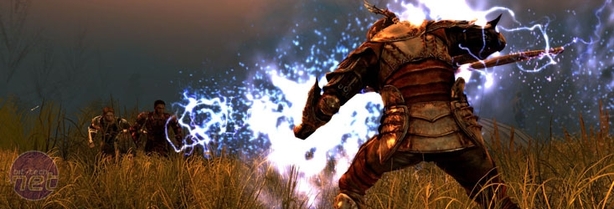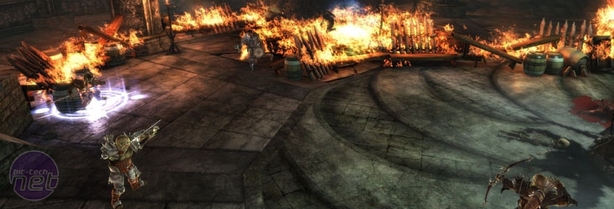Bio BeWare
BioWare hasn’t just been redesigning the graphics and morality systems though – there’s been a whole lot more work that’s gone into Dragon Age: Origins than you’d think.One of the unusual areas that BioWare has focused its attention for example is on the new spell interference and interaction mechanic, which lets players build spells into some physical affects on occasion. Grease spells now create an oily residue which not only hampers enemy movements but can, for example, be set ablaze with a fire spell.
Likewise, water can be frozen with ice spells or electrocuted with lightning and certain environmental features of the game can be interacted with, such as setting fire to barricades to create infernos that you can injure and block foes with.
Be warned though – spell interactions are a double-edged sword and the enemy can turn these effects around on you just as quickly, even using the same idea to clear your characters of buffs and defences.
Making good use of buffs and special moves is critical to getting at all far in Dragon Age: Origins too, at least as far as our experience goes. While in some RPG games there tend to be some filler spells and abilities (who needs ‘Bless’ and ‘Aid’, honestly?) the combat in Dragon Age is pretty difficult stuff and you’ll need all your skills to prevail.
Just because there are only three base classes available to your character doesn’t mean that this is all there is in the game either – you can take up to three NPCs with you on your travels and they each have some unique abilities. One of the mages you can recruit for example, Morrigan, goes beyond the ability to throw fireballs and can shapeshift into other animals and creatures.
Managing all four characters at your disposal in real-time could potentially be quite difficult though, so BioWare has again gone back to its old games catalogue and used a system that lets you pause whenever you want and set the next action for your minions. As with Baldur’s Gate you can also set up a system that auto-pauses the game on certain conditions – when an enemy is spotted or when an ally is slain for example.
The interface for the game is actually remarkably similar to the Baldur’s Gate games too, with a fully iconic list of special abilities at the bottom of the screen for players to scroll through and choose attacks from. Hovering over each icon gives you a quick run-down on what each skill does, which is undeniably handy when you’re dumped in front of a PC and hurriedly told to play it by an EA rep.
In fact, when you get right down to it, BioWare’s latest RPG epic is so strikingly similar to its previous games that it’s hard to find many faults with it. It’s a tad formulaic in presentation obviously, but it’s a formula that BioWare has got down to an absolute tee. The last half dozen games the company has made may be fundamentally very similar, but they’re also undeniably very good too.
The one flaw that we might struggle to raise with Dragon Age: Origins is that it’s just a little bit too similar to BioWare’s past greats – to the extent that it’s starting to become predictable how little we have to worry about the quality of the game.
In our time with the game we got a chance to look at two very specific quests we’ve promised not to give specifics on, but we will say that they felt very familiar. Aren’t these the same werewolves we killed in Icewind Dale? Wasn’t this tower in Throne of Bhaal too? Much of what we saw didn’t feel totally new, rather it was just redecorated.
We liked Dragon Age: Origins an awful lot. Already we can tell that it’s shaping up to be a fantastically balanced and well written game and we don’t doubt that we’ll sink countless hours into it and that we’ll still be playing it in years to come – just like we do with BioWare’s other games.
Dragon Age: Origins is currently expected to be released in Q3 2009 on the PC, Xbox 360 and PlayStation 3 and will be published by Electronic Arts.

MSI MPG Velox 100R Chassis Review
October 14 2021 | 15:04












Want to comment? Please log in.